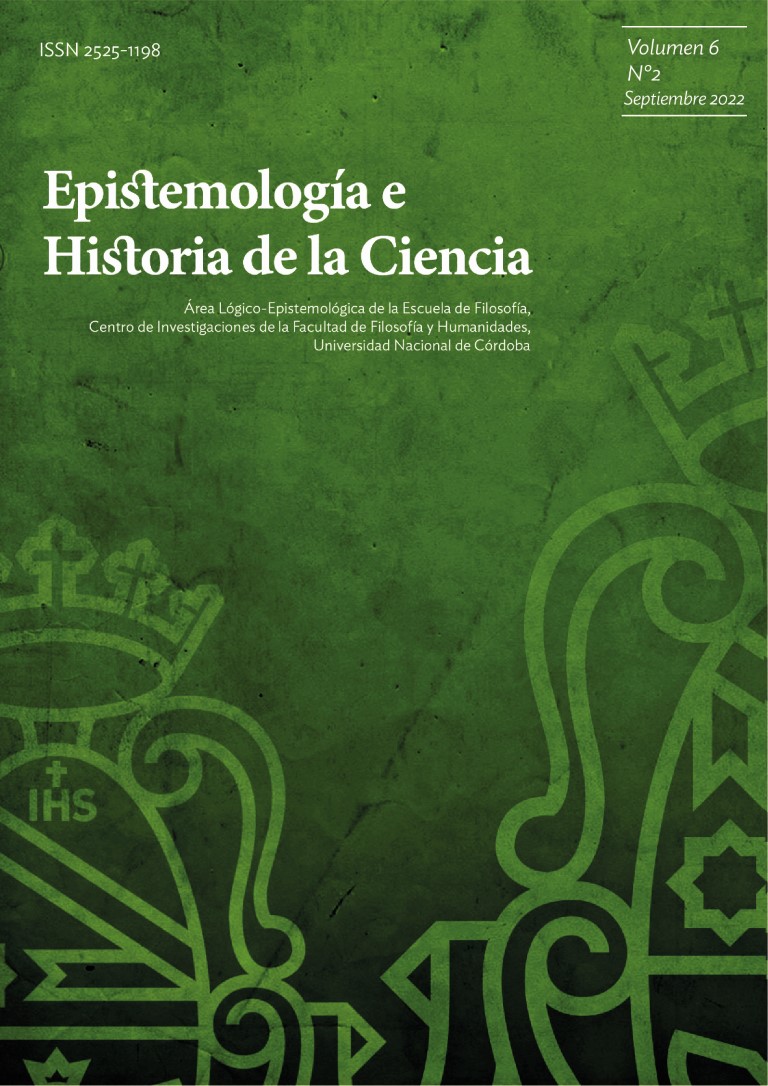Some considerations on Heisenberg's philosophical reflections on elementary particle physics
Keywords:
Werner Heisenberg, philosophy of science, atomism, Martin HeideggerAbstract
In this article, we present a description of the philosophy of elementary particles developed by Werner Heisenberg. In addition to describing his theses on the nature of the so-called elementary particles, we will also try to understand the German physicist's motives for sending to Heidegger's 70th birthday Festschrift a complicated text from the scientific point of view and with no direct relationship to the philosophy of the author of Sein und Zeit. Our hypothesis is that Heisenberg intended to perform a double movement. While positioning himself in favour of closer relations between science and philosophy, Heisenberg refused to accept some of Heidegger's negative positions in relation to science, which, according to the latter, was already dominated by the Gestell.
References
Bleuler, K. (1990). Werner Heisenberg's Ideas on Particle Physics in the Light of Recent Achievements. Zeitschrift für Naturforschung, 45a, 1051-1058.
Blum, A. (2019). Heisenberg’s 1958 Weltformel and the Roots of Post-Empirical Physics. Springer Verlag.
Blum, A., Dürr, H-P., &, Rechenberg, H. (Eds.). (1984. Physik und Erkenntnis 1956-1968 Werner Heisenberg, Gesammelte Werke, Abteilung C; Allgemeinverständliche Schriften (Band II). Piper.
Cao, T. Y. (2019). Conceptual Developments of 20th Century Field Theories. Cambridge University Press.
Carson, C. (2010). Science as instrumental reason: Heidegger, Habermas, Heisenberg. Continental Philosophical Review, 42, 483-509. doi: 10.1007/s11007-009-9124-y.
Carson, C. (2011). Modern or antimodern science? Weimar Culture, Natural science, and the Heidegger-Heisenberg Exchange. Em: C. Carson, A. Kojevnikov, & H. Trischler (Eds.), Weimar Culture and Quantum Mechanics: Selected papers by Paul Forman and Contemporary Perspectives on the Forman Thesis (pp. 523-542). Imperial College Press.
Cassidy, D. (2015). Werner Heisenberg and Carl Friedrich Freiherr von Weizsäcker: A Fifty-Year Friendship. Physics in Perspective, 17, 33-54.
Cushing, J. (1986). The Importance of Heisenberg's S‐Matrix Program for the Theoretical High‐Energy Physics of the 1950's. Centaurus, 29(2), 110-149.
Heelan, P. (2016). The observable: Heisenberg's Philosophy of Quantum Mechanics. Peter Lang Publishing, Inc.
Heisenberg, W. (1934). Atomtheorie und Naturerkenntnis. Universitätsbund Göttingen: Mitteilungen, 16(1), 9-20.
Heisenberg, W. (Ed.). (1943). Kosmische Strahlung: Vorträge gehalten im Max Planck-Institut, Berlin-Dahlem. Springer.
Heisenberg, W. (1950). Quantentheorie der Elementarteilchen. Zeitschrift für Naturforschung, 5a, 251-259.
Heisenberg, W. (1971). Die Bedeutung des Schönen in der exakten Naturwissenschaft. Physikalische Blätter, 27(3), 97-107.
Heisenberg, W. (1976). The Nature of Elementary Particle Physics. Physic Today, 29(3), 32-39.
Heisenberg, W. (1984a). Die Plancksche Entdeckung und die philosophischen Probleme der Atomphysik Em: W. Blum, W.; H-P. Dürr, & H. Rechenberg (Eds.), Physik und Erkenntnis 1956-1968 Werner Heisenberg, Gesammelte Werke, Abteilung C; Allgemeinverständliche Schriften (Band II, pp. 235-248). (Trabalho original publicado em 1959)
Heisenberg, W. (1984b). Grundlegende Voraussetzungen in der Physik der Elementarteilchen. Em: W. Blum, W.; H-P. Dürr, & H. Rechenberg (Eds.), Physik und Erkenntnis 1956-1968 Werner Heisenberg, Gesammelte Werke, Abteilung C; Allgemeinverständliche Schriften (Band II, pp. 249-255). Piper. (Trabalho original publicado em 1959)
Heisenberg, W.; Born, M.; Schrödinger, E., & Auger, P. (1962). On Modern Physics. Collier Books.
Pais, A. (1986). Inward Bound: Of Matter and Forces in the Physical World. Clarendon Press & Oxford University Press.
Platão. (1963). Timaeus (J. Burnet, Transl.). Oxford University Press.
Pöggeler, O. (1993). The Hermeneutics of the Technological World: The Heidegger‐Heisenberg Dispute. International Journal of Philosophical Studies. 1(1), 21-48. DOI: 10.1080/09672559308570760.
Princeton (2019). Particle Phenomenology. Obtido em: https://phy.princeton.edu/research/particle-phenomenology. Consultado em 22/11/2019.
Rechenberg, H. (1992). Heisenberg and Pauli. Their Program of a Unified Quantum Field Theory of Elementary Particles (1927-1958). MPI-Ph/92-.58, July. https://lib-extopc.kek.jp/preprints/PDF/1992/9210/9210564.pdf
Redhead, M.L.G. (1980). Some Philosophical Aspects of Particle Physics. Studies in History and Philosophy of Science. 11(4), 279-304.
Schöning, M. (Ed.). (2014). Ernts Jünger Handbuch: Leben-Werk-Wirkung. J. B. Metzler.
Weizsäcker, C. F. v. (1983). Heisenberg und Heidegger über das Schöne und die Kunst IN Wahrnehmung der Neuzeit. Carl Hanser Verlag.
Weizsäcker, C. F. v. (1949). Beziehungen der theoretischen Physik zu Denken Heideggers. Em: C. Astrada. Martin Heideggers Einfluss auf die Wissenschaften (pp. 172-174). A. Francke AG Verlag.
Downloads
Published
Issue
Section
License
Copyright (c) 2022 Epistemología e Historia de la Ciencia

This work is licensed under a Creative Commons Attribution-NonCommercial-NoDerivatives 4.0 International License.
En todos los lugares donde aplique, esta obra está bajo una licencia Creative Commons Reconocimiento-NoComercial-SinObrasDerivadas 4.0 .
- Los autores/as conservarán sus derechos de autor y garantizarán a la revista el derecho de primera publicación de su obra, el cual estará simultáneamente sujeto a la Licencia de reconocimiento de Creative Commons que permite a terceros compartir la obra, siempre que se indique su autor y su primera publicación en esta revista.
- Los autores/as podrán adoptar otros acuerdos de licencia no exclusiva de distribución de la versión de la obra publicada (p. ej.: depositarla en un archivo digital institucional o publicarla en un volumen monográfico), siempre que se indique la publicación inicial en esta revista.
- Se permite y recomienda a los autores/as difundir su obra a través de Internet (p. ej.: en archivos digitales institucionales o en su página web) antes y durante el proceso de envío.
- Las licencias de las imágenes de terceros incluidas en los artículos pueden estar sujetas a otros términos; los autores/as son responsables de asegurar la veracidad de su origen, la información de la fuente original provista y su permiso de reproducción en esta publicación, que puede ser exclusivo.







